German-American actor Peter van Eyck (1911-1969) was best known for the classic French thriller Le Salaire de la Peur/The Wages of Fear (1953). With his whitish blond crew-cut, Van Eyck was destined to be typecast in international war films as the arrogant Nazi.

East-German postcard by VEB Progress Film-Vertrieb, Berlin, no. 1057, 1959. Retail price: 0,20 DM. Photo: Roxi-Film.
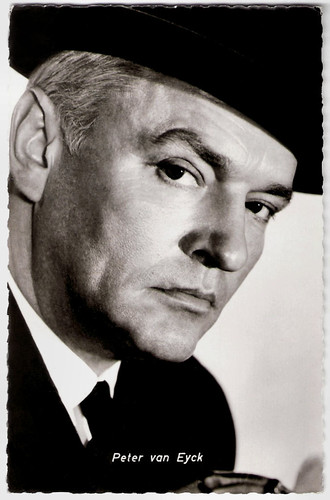
German postcard by Kolibri-Verlag G.m.b.H, Minden / Westf., no. 755. Photo: Europa / Gabriele du Vinage.
Peter van Eyck was born Götz von Eick in Steinwehr, Germany (now Kamienny Jaz, Poland) in 1911. He was the son of an aristocratic Prussian landowner. His father intended for him to embark on a military career, but Peter spent his education in Berlin, where he studied music.
In 1931, he left Germany, living in Paris, London, Tunis, Algiers and Cuba before settling in New York. There, he became acquainted with the composer Aaron Copland, which led to a collaboration, as well as solo efforts, as composer and lyricist on a variety of songs for revue and cabaret. He also moonlighted as a pianist in bars and nightclubs. Around this time, he also began to work as a stage manager and arranger for Irving Berlin. He then worked for a while with Orson Welles at the Mercury Theatre company as an assistant director.
As a truck driver, Van Eyck went to Hollywood. There, he initially found radio work with the help of Billy Wilder, who he knew from Berlin. Wilder also helped him make his film debut in The Moon is Low (Irving Pichel, 1943), a downbeat drama about German troops invading Norway during WWII, based on a novel by John Steinbeck.
Wilder also gave Van Eyck a small role as a German soldier in the World War II drama Five Graves to Cairo (Billy Wilder, 1943), starring Franchot Tone. Van Eyck had a bigger part, again as a Nazi, in the propaganda film Address Unknown (William Cameron Menzies, 1944) about two families caught up in the rise of Nazism in Germany before the start of World War II. He also played in the American propaganda drama The Impostor (Julien Duvivier, 1944) starring Jean Gabin. In 1943 Van Eyck took US citizenship and was drafted into the army as a commissioned officer.
At the end of the war, he returned to Germany as a film officer for the 'Office of Military Government, United States' (OMGUS) and remained there until 1948 as director of the film section. In 1949 he appeared in his first German film Hallo, Fräulein!/Hello Fraulein (Rudolf Jugert, 1949), ironically cast as an American. He also appeared as an American in the comedy Königskinder/Royal Children (Helmut Käutner, 1950), with Jenny Jugo.
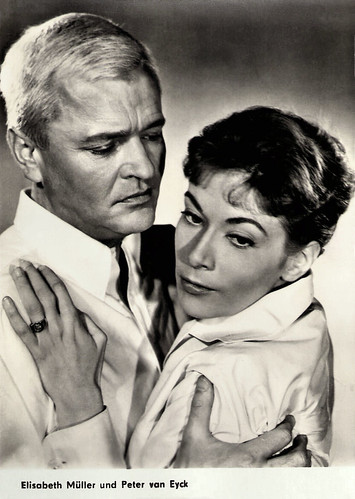
East-German postcard by VEB Progress Film-Vertrieb, Berlin, no. 1535, 1961. Retail price: 0,20 DM. Photo: publicity still for Dr. Crippen lebt/Doctor Crippen lives (Erich Engels, 1958) with Elisabeth Müller.
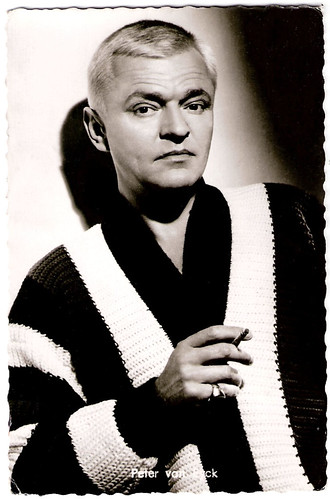
German postcard by Kolibri-Verlag G.m.b.H, Minden / Westf., no. 2920. Photo: Bavaria / Schorcht / Vogelmann. Publicity still for Der Gläserne Turm/The Glass Tower (Harald Braun, 1957).
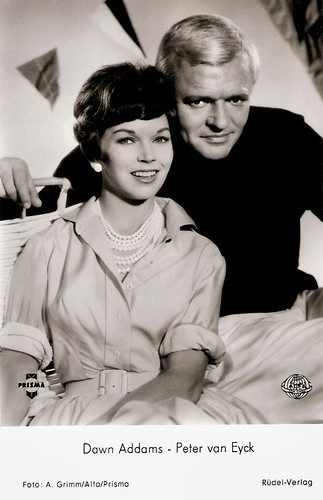
German postcard by Rüdel-Verlag, Hamburg-Bergedorf, no. 2852. Photo: Arthur Grimm / Alfa / Prisma. Publicity still for Geheimaktion Schwarze Kapelle/The Black Chapel (Ralph Habib, 1959) with Dawn Addams.
Peter van Eyck gained international recognition with a leading role in the French-Italian thriller Le Salaire de la peur/The Wages of Fear (1953) directed by Henri-Georges Clouzot. When a South American oil well owned by an American company catches fire, the company hires four European daredevils (Yves Montand, Charles Vanel, Folco Lulli and Van Eyck as the Dutchman Bimba) as truck drivers to traverse an impenetrable South American jungle with a deadly load of nitro-glycerine.
In English-language films, he was most often typecast as a Nazi or another unsympathetic type, such as in The Desert Fox (Henry Hathaway, 1951) a biographical film about Field Marshal Erwin Rommel (James Mason) in the later stages of World War II. This was ironic, because Van Eyck was an avowed anti-fascist. Other examples of this typecasting are the British war film Single-Handed/Sailor of the King (Roy Boulting, 1953) starring Jeffrey Hunter and Michael Rennie, and the American war film Attack! (Robert Aldrich, 1956) starring Jack Palance and Lee Marvin.
Van Eyck went on to appear in episodes of several US TV series including The Adventures of Ellery Queen (1955) and Alfred Hitchcock Presents (1956). In France, he appeared opposite Gina Lollobrigida and Jean-Claude Pascal in the drama Le Grand Jeu/Flesh and the Woman (Robert Siodmak, 1954) which was entered into the 1954 Cannes Film Festival.
He worked with Orson Welles again at the French-Spanish-Swiss co-production Mr. Arkadin/Confidential Report (Orson Welles, 1955). Like many of Welles's other films, Mr. Arkadin was heavily edited without his input. Another French production was the crime drama Retour de manivelle/There's Always a Price Tag (Denys de La Patellière, 1957), based on the novel by James Hadley Chase. The film stars Michèle Morgan and Daniel Gélin.
He also played the womanising Frenchman Fribert in Das Mädchen Rosemarie/The Girl Rosemarie (Rolf Thiele, 1958) featuring Nadja Tiller, and a police inspector investigating a famous murder in Dr. Crippen lebt/Dr.Crippen lives (Erich Engels, 1958), with Elisabeth Müller. Also interesting was the crime drama Verbrechen nach Schulschluß/The Young Go Wild (Alfred Vohrer, 1959) with Christian Wolff.
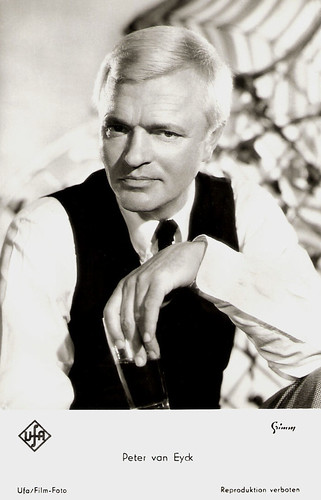
German postcard by Ufa, Berlin-Tempelhof, no. FK 4779. Retail price: 25 Pfg. Photo: Grimm / Ufa.
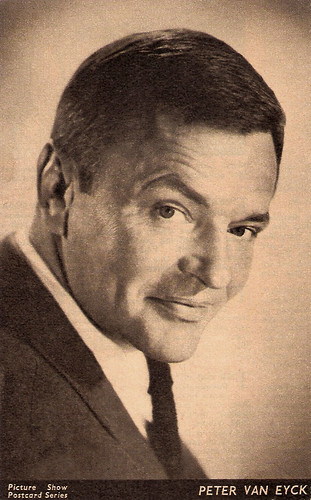
British postcard in the Picture Show Postcard Series.
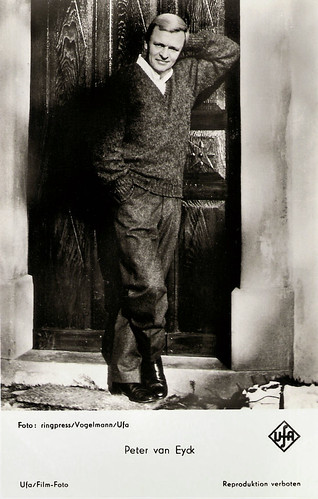
German postcard by Ufa, Berlin-Tempelhof, no. FK 4815. Photo: Ringpress / Vogelmann / Ufa.
In Germany, Peter van Eyck was a popular leading man in a wide range of films. In 1959 he appeared opposite Hardy Krüger in the West German crime film Der Rest ist Schweigen/The Rest Is Silence (Helmut Käutner, 1959), which was entered into the 9th Berlin International Film Festival. He starred in three Doctor Mabuse thrillers, starting with Die 1000 Augen des Dr. Mabuse/Diabolical Dr. Mabuse (Fritz Lang, 1960) with Wolfgang Preiss as Dr. Mabuse.
He also starred as an overly dedicated scientist in the Anglo-German production Ein Toter sucht seinen Mörder/The Brain (Freddie Francis, 1962) the third film version of the Curt Siodmak scare piece Donovan's Brain. When a powerful and ruthless financier dies in a plane crash, Van Eyck keeps the tycoon's brain alive in his laboratory. The brain compels Van Eyck to seek out the financier's murderer. Van Eyck continued to appear in international war films, including the British production Foxhole in Cairo (John Llewellyn Moxey, 1960) based upon the real-life Operation Salaam. He also was among the ensemble cast of The Longest Day (Darryl F. Zanuck, Bernhard Wicki, a.o., 1962), about D-Day, the Normandy landings on 6 June 1944, during World War II.
He had a supporting part as the East German intelligence officer Mundt in the British Cold War spy film The Spy Who Came in from the Cold (Martin Ritt, 1965), starring Richard Burton and based on the novel by John le Carré. He also appeared in the British Western Shalako (Edward Dmytryk, 1968), starring Sean Connery and Brigitte Bardot, which was filmed in Spain.
His final film was the war film The Bridge at Remagen (John Guillermin, 1969), a highly fictionalised version of actual events during the last months of World War II when the U.S. 9th Armored Division approached Remagen and found the Ludendorff Bridge still intact. The bridge, named for General Erich Ludendorff, is never actually mentioned by name in the film, which re-enacts the week-long battle and several artillery duels that the Americans fought before gaining a bridgehead across the Rhine for their final push into Germany.
Van Eyck was married to the American actress Ruth Ford from 1940 to 1945. With his second wife, Inge von Voris, he had two daughters, actress Kristina van Eyck, and Claudia van Eyck. At the age of 57, Peter van Eyck died of sepsis in 1969 in Männedorf near Zürich, Switzerland, after he had left a relatively small injury untreated.
Trailer Dr. Crippen lebt/Dr.Crippen lives (1958). Source: Arild Rafalzik (YouTube).
Sources: I.S. Mowis (IMDb), Hal Erickson (AllMovie), Prisma.de (German), Wikipedia, and IMDb.
This post was last updated on 23 February 2024.

East-German postcard by VEB Progress Film-Vertrieb, Berlin, no. 1057, 1959. Retail price: 0,20 DM. Photo: Roxi-Film.

German postcard by Kolibri-Verlag G.m.b.H, Minden / Westf., no. 755. Photo: Europa / Gabriele du Vinage.
A German truck driver in Hollywood
Peter van Eyck was born Götz von Eick in Steinwehr, Germany (now Kamienny Jaz, Poland) in 1911. He was the son of an aristocratic Prussian landowner. His father intended for him to embark on a military career, but Peter spent his education in Berlin, where he studied music.
In 1931, he left Germany, living in Paris, London, Tunis, Algiers and Cuba before settling in New York. There, he became acquainted with the composer Aaron Copland, which led to a collaboration, as well as solo efforts, as composer and lyricist on a variety of songs for revue and cabaret. He also moonlighted as a pianist in bars and nightclubs. Around this time, he also began to work as a stage manager and arranger for Irving Berlin. He then worked for a while with Orson Welles at the Mercury Theatre company as an assistant director.
As a truck driver, Van Eyck went to Hollywood. There, he initially found radio work with the help of Billy Wilder, who he knew from Berlin. Wilder also helped him make his film debut in The Moon is Low (Irving Pichel, 1943), a downbeat drama about German troops invading Norway during WWII, based on a novel by John Steinbeck.
Wilder also gave Van Eyck a small role as a German soldier in the World War II drama Five Graves to Cairo (Billy Wilder, 1943), starring Franchot Tone. Van Eyck had a bigger part, again as a Nazi, in the propaganda film Address Unknown (William Cameron Menzies, 1944) about two families caught up in the rise of Nazism in Germany before the start of World War II. He also played in the American propaganda drama The Impostor (Julien Duvivier, 1944) starring Jean Gabin. In 1943 Van Eyck took US citizenship and was drafted into the army as a commissioned officer.
At the end of the war, he returned to Germany as a film officer for the 'Office of Military Government, United States' (OMGUS) and remained there until 1948 as director of the film section. In 1949 he appeared in his first German film Hallo, Fräulein!/Hello Fraulein (Rudolf Jugert, 1949), ironically cast as an American. He also appeared as an American in the comedy Königskinder/Royal Children (Helmut Käutner, 1950), with Jenny Jugo.

East-German postcard by VEB Progress Film-Vertrieb, Berlin, no. 1535, 1961. Retail price: 0,20 DM. Photo: publicity still for Dr. Crippen lebt/Doctor Crippen lives (Erich Engels, 1958) with Elisabeth Müller.

German postcard by Kolibri-Verlag G.m.b.H, Minden / Westf., no. 2920. Photo: Bavaria / Schorcht / Vogelmann. Publicity still for Der Gläserne Turm/The Glass Tower (Harald Braun, 1957).

German postcard by Rüdel-Verlag, Hamburg-Bergedorf, no. 2852. Photo: Arthur Grimm / Alfa / Prisma. Publicity still for Geheimaktion Schwarze Kapelle/The Black Chapel (Ralph Habib, 1959) with Dawn Addams.
Typecast as a Nazi or another unsympathetic type
Peter van Eyck gained international recognition with a leading role in the French-Italian thriller Le Salaire de la peur/The Wages of Fear (1953) directed by Henri-Georges Clouzot. When a South American oil well owned by an American company catches fire, the company hires four European daredevils (Yves Montand, Charles Vanel, Folco Lulli and Van Eyck as the Dutchman Bimba) as truck drivers to traverse an impenetrable South American jungle with a deadly load of nitro-glycerine.
In English-language films, he was most often typecast as a Nazi or another unsympathetic type, such as in The Desert Fox (Henry Hathaway, 1951) a biographical film about Field Marshal Erwin Rommel (James Mason) in the later stages of World War II. This was ironic, because Van Eyck was an avowed anti-fascist. Other examples of this typecasting are the British war film Single-Handed/Sailor of the King (Roy Boulting, 1953) starring Jeffrey Hunter and Michael Rennie, and the American war film Attack! (Robert Aldrich, 1956) starring Jack Palance and Lee Marvin.
Van Eyck went on to appear in episodes of several US TV series including The Adventures of Ellery Queen (1955) and Alfred Hitchcock Presents (1956). In France, he appeared opposite Gina Lollobrigida and Jean-Claude Pascal in the drama Le Grand Jeu/Flesh and the Woman (Robert Siodmak, 1954) which was entered into the 1954 Cannes Film Festival.
He worked with Orson Welles again at the French-Spanish-Swiss co-production Mr. Arkadin/Confidential Report (Orson Welles, 1955). Like many of Welles's other films, Mr. Arkadin was heavily edited without his input. Another French production was the crime drama Retour de manivelle/There's Always a Price Tag (Denys de La Patellière, 1957), based on the novel by James Hadley Chase. The film stars Michèle Morgan and Daniel Gélin.
He also played the womanising Frenchman Fribert in Das Mädchen Rosemarie/The Girl Rosemarie (Rolf Thiele, 1958) featuring Nadja Tiller, and a police inspector investigating a famous murder in Dr. Crippen lebt/Dr.Crippen lives (Erich Engels, 1958), with Elisabeth Müller. Also interesting was the crime drama Verbrechen nach Schulschluß/The Young Go Wild (Alfred Vohrer, 1959) with Christian Wolff.

German postcard by Ufa, Berlin-Tempelhof, no. FK 4779. Retail price: 25 Pfg. Photo: Grimm / Ufa.

British postcard in the Picture Show Postcard Series.

German postcard by Ufa, Berlin-Tempelhof, no. FK 4815. Photo: Ringpress / Vogelmann / Ufa.
Doctor Mabuse
In Germany, Peter van Eyck was a popular leading man in a wide range of films. In 1959 he appeared opposite Hardy Krüger in the West German crime film Der Rest ist Schweigen/The Rest Is Silence (Helmut Käutner, 1959), which was entered into the 9th Berlin International Film Festival. He starred in three Doctor Mabuse thrillers, starting with Die 1000 Augen des Dr. Mabuse/Diabolical Dr. Mabuse (Fritz Lang, 1960) with Wolfgang Preiss as Dr. Mabuse.
He also starred as an overly dedicated scientist in the Anglo-German production Ein Toter sucht seinen Mörder/The Brain (Freddie Francis, 1962) the third film version of the Curt Siodmak scare piece Donovan's Brain. When a powerful and ruthless financier dies in a plane crash, Van Eyck keeps the tycoon's brain alive in his laboratory. The brain compels Van Eyck to seek out the financier's murderer. Van Eyck continued to appear in international war films, including the British production Foxhole in Cairo (John Llewellyn Moxey, 1960) based upon the real-life Operation Salaam. He also was among the ensemble cast of The Longest Day (Darryl F. Zanuck, Bernhard Wicki, a.o., 1962), about D-Day, the Normandy landings on 6 June 1944, during World War II.
He had a supporting part as the East German intelligence officer Mundt in the British Cold War spy film The Spy Who Came in from the Cold (Martin Ritt, 1965), starring Richard Burton and based on the novel by John le Carré. He also appeared in the British Western Shalako (Edward Dmytryk, 1968), starring Sean Connery and Brigitte Bardot, which was filmed in Spain.
His final film was the war film The Bridge at Remagen (John Guillermin, 1969), a highly fictionalised version of actual events during the last months of World War II when the U.S. 9th Armored Division approached Remagen and found the Ludendorff Bridge still intact. The bridge, named for General Erich Ludendorff, is never actually mentioned by name in the film, which re-enacts the week-long battle and several artillery duels that the Americans fought before gaining a bridgehead across the Rhine for their final push into Germany.
Van Eyck was married to the American actress Ruth Ford from 1940 to 1945. With his second wife, Inge von Voris, he had two daughters, actress Kristina van Eyck, and Claudia van Eyck. At the age of 57, Peter van Eyck died of sepsis in 1969 in Männedorf near Zürich, Switzerland, after he had left a relatively small injury untreated.
Trailer Dr. Crippen lebt/Dr.Crippen lives (1958). Source: Arild Rafalzik (YouTube).
Sources: I.S. Mowis (IMDb), Hal Erickson (AllMovie), Prisma.de (German), Wikipedia, and IMDb.
This post was last updated on 23 February 2024.
No comments:
Post a Comment